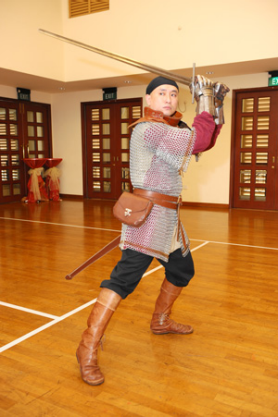SWORD FIGHT, ANYONE?
PHOTO // Chai Sian Liang
Some guys practise their golf swing on weekends. Major (MAJ) Loh Heng Sin, on the other hand, prefers to get his grip behind a medieval sword. Find out what is attractive about medieval sword-fighting and why he is so hooked on it.
What started out as a curiosity soon turned into a passion like no other. While others have hobbies like stamp collecting, gaming, or sports, MAJ Loh's hobby comes in the form of Historical European Martial Arts (HEMA) or medieval sword-fighting.
In fact, the 38-year-old Staff Officer from the Naval Intelligence Department (NID) enjoys the activity so much, he has been at it for four years.
"Medieval swordsmanship is different from your normal run-of-the-mill martial arts, and it's more combat-oriented. Current martial arts tend to be more sports-oriented," he explained.
"It's also a very good workout. You have no idea how tiring it is to wield a 1.5kg sword for half an hour!"
Learning from history
History buff MAJ Loh was researching the history of naval warfare and reading up on boarding actions during the era of wooden ships, when he chanced upon old sword manuals from the 1800s. That sparked an interest in him, and a few more online searches eventually led him to a class by the Pan-Historical European Martial Arts Society in Singapore which offered lessons on historical swordsmanship.
He jumped at the opportunity and has not looked back since. What MAJ Loh found particularly appealing about this historical art form was the fact that very little is known about European martial arts since the development of firearms.
"When someone mentions martial arts, the first thing that comes to mind is usually 'Eastern'. The beauty of this lost martial art form comes from reconstructing sword moves from Italian manuals dating back all the way to the 14th century," he said.
Training as a knight
In fact, MAJ Loh has such passion for the art, he collected the full set of gear that a medieval knight or man-at-arms would have worn in combat. This consists of chain mail and shoulder armour, padded cloth armour, leather boots and, of course, a steel sword.
"There are some moves that don't quite make sense until you don the armour," he explained. "The armour also acts as a safety gear, and there is no one-size-fits-all."
To prove his point, MAJ Loh revealed that he made his own chain mail from scratch by chaining little metal rings together. It took him about six months before he finally completed the 14kg armour.
MAJ Loh feels fortunate that his time in the Singapore Armed Forces (SAF) has built up qualities of perseverance and mental alertness that have come in useful when practising HEMA. "My experience in the SAF has taught me to persevere, even when two hours into training, the 1.5kg sword starts to feel like it's 15kg. It has also taught me to be alert and stay safe when I have to go up against another student with a steel sword at full speed," he said.
"I like the fact that there's always something new to learn or experience in HEMA, just like how sailing with the Navy has broadened my perspectives and horizons," he added.
Different walks of life
Now a HEMA practitioner in the advanced class, there is no doubt that the naval officer has found some bosom buddies in the club. While he admits that his male-dominant class consists of a very "strange mix", which includes a policeman, a 15-year-old school girl, and several undergraduates, they are a very close-knit bunch.
"We all share a passion for history despite coming from different walks of life. A typical dinner conversation after class can range from the history of swordsmen to philosophy, or online games and mathematics," said MAJ Loh.
However, with the addition of his nine-month-old son to the family, the new father has not had time to attend classes for quite a while as he is busy attending to the baby. With a laugh, he said that his greatest workout now is doing "bicep-curls" with his son.
Despite this new commitment, his passion for HEMA has not waned. Summing up, he said: "HEMA started out as a hobby for me. It was a way to work out in an unusual way, and many of the manoeuvres and techniques described in the historical manuals are still as relevant today as a self-defence system as they were back then. Along the way, I've found a passion for history, and more importantly, many close friends who share the same passion and interest."










